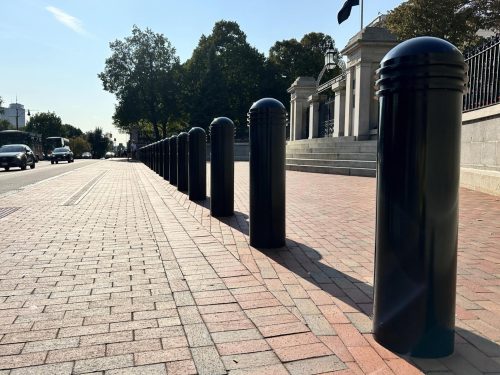
Average reading time: 5 minutes
At Barrier1 Systems, our bollards are designed with protection in mind. Our sturdy security posts protect people and businesses from damage and adhere to the codes that local jurisdictions require for the sake of public safety, accessibility, and standardization. This is the case for all of our product types and subtypes, including:
- Safety bollards
- Shallow mount bollards
- Super shallow mount bollards
- Set and pour bollards
- Retractable bollards
The Major Bollard Code Requirement Systems (IBC, ADA, ASTM)
There are three sources that dictate bollard code requirements. For example, the International Building Code (IBC) offers general protection guidelines for structures and pedestrian areas. The Americans with Disabilities Act (ADA) ensures that bollards are placed so that they don’t cause accessibility problems. The American Society of Testing and Materials (ASTM) ensures that bollards are structurally capable of withstanding vehicle impacts. Here’s a more detailed breakdown of each:
The International Building Code (IBC) Code Requirements
For protecting structures, the IBC was a code developed by the International Code Council (ICC). Many local and state jurisdictions have since adopted the code as a means of protecting pedestrian areas from vehicular impacts. While bollards aren’t explicitly named as a protection mechanism, bollard installation has almost become the standard. Many local codes use the IBC as a general guide to specify code requirements for bollards. While precise specs aren’t outlined for bollards, most jurisdictions require these basic specifications for barriers:
- Minimum height: Typically 36 to 48 inches above grade
- Embedment depth: Commonly 3 to 5 feet set within reinforced concrete
- Spacing: Usually 3 to 5 feet apart to prevent vehicle passage
IBC section 312 requires barriers, like bollards, to protect mechanical, plumbing, or electrical equipment from vehicles. Additionally, emergency access must not be inhibited by any barrier so that fire department personnel aren’t prevented from responding to emergency situations. IBC codes also specify that barriers must separate vehicles from pedestrian areas, like exits and walkways, within parking structures.
Americans with Disabilities Act (ADA) Code Requirements
Bollards, as structures designed to protect people as well as property, must also comply with codes established by the ADA. Here’s how bollard installation must also allow accessibility for individuals with disabilities:
| ADA Specification | Specifications | Code/Guidance |
|---|---|---|
| Width | Should be a minimum of 36 inches between bollards | Barriers, like bollards, must allow for wheelchair passage into and out of the protected area |
| Protrusion | The maximum degree of projection is four inches into the walkway | No object can project into walkways that might inhibit passage. This is typically between 27 and 80 inches from ground level |
| Detectability | Tactile surfaces, surface indicators, or color contrast must be implemented | Bollards need to be visually detectable and should have tactile features for those with visual impairments |
| Surface Placement | The base of the bollard must be flush or beveled to avoid trip hazards | Bollards should not impede or interfere with accessible walking surfaces |
The American Society of Testing and Materials (ASTM) Bollard Code Requirements
ASTM International is a standards organization that provides testing guidelines for products across various industries, including safety barriers like bollards. For bollards, ASTM standards such as F3016 and F2656 establish how these posts are tested for impact resistance, helping ensure they meet specific safety and security needs. Here are the two most commonly used code standards for bollards:
| ASTM Standard | Vehicle Weight Classes | Test Speeds (mph) | Penetration Ratings |
|---|---|---|---|
| ASTM F2656 | Small cars (SC) – ~2,430 lbs Full-size sedans (FS) – ~4,630 lbs Pickup trucks (PU) – ~5,070 lbs Medium-duty trucks (M) – ~15,000 lbs Class 7 cabovers (C7) – ~15,873 lbs Heavy goods vehicles (H) – ~65,000 lbs | 30, 40, 50, 60 | P1: ≤ 3.3 ft (1 m) P2: 3.31–23 ft (1.01–7 m) P3: 23.1–98.4 ft |
| ASTM F3016 | Up to 5,000 lbs (SUV or full-size pickup) | 10, 20, 30 | P1: ≤ 1 ft P2: 1–4 ft |
Bollard Requirements in the Top 10 Largest U.S. Cities
Bollard code requirements come from a wide array of sources, such as governmental organizations, industry standards, and local building regulations. When determining how a bollard project adheres to code requirements, it’s critical to recognize that each authoritative body, which includes federal, state, and local governments, may have different rules and standards.
However, as is made clear by the following table, many codes in some of the country’s largest cities cover several core aspects of bollard design, with requirements being relatively uniform:
| City | Minimum Height Requirement | Spacing Requirement | ASTM Standard |
|---|---|---|---|
| New York City | 36 inches | 3 to 5 feet apart | ASTM F2656 |
| Los Angeles | 36 inches | 3 to 5 feet apart | ASTM F2656 |
| Chicago | 30 inches* | 3 to 5 feet apart | ASTM F2656 |
| Houston | 36 inches | 3 to 5 feet apart | ASTM F2656 |
| Phoenix | 36 inches | 3 to 5 feet apart | ASTM F2656 |
| Philadelphia | 36 inches | 3 to 5 feet apart | ASTM F2656 |
| San Antonio | 36 inches | 3 to 5 feet apart | ASTM F2656 |
| San Diego | 36 inches | 3 to 5 feet apart | ASTM F2656 |
| Dallas | 36 inches | 3 to 5 feet apart | ASTM F2656 |
| San Jose | 36 inches | 3 to 5 feet apart | ASTM F2656 |
**Chicago: The 30-inch minimum height is referenced in city streetscape and site plan standards, often as a maximum height for objects within sight triangles rather than a universal bollard minimum. Most general bollard installations in Chicago still follow the 36–48 inch de facto industry standard unless otherwise specified for specific safety or visibility zones.
The Organizations That Create and Enforce Bollard Codes
Navigating the world of bollard code requirements is complex, especially since there are multiple levels from which these codes originate. These include:
- The federal level
- The state level
- The regional/county level
In this section, we at Barrier1 Systems will break down how each of these levels affects bollard code requirements.
The Federal Level
When looking at bollard code requirements at the federal level, typically, these are codes instituted by the Department of Homeland Security (DHS), the Department of Transportation (DOT), the General Services Administration (GSA), or the Americans with Disabilities Act (ADA).
For those codes originating from the DHS and GSA, these are typically mandatory for federal facilities so that a uniform level of security is provided against potential vehicle attacks (ram raiding) or accidents.
For the DOT-originating codes, these are designed to set standards specifically for transportation infrastructure and pedestrian safety. DOT code adherence is mandatory for federally funded transportation projects.
In addition to these federal agencies, ADA compliance is also mandatory for the sake of facility accessibility. For the ADA, the enforcing agency is the Department of Justice, and codes instituted by the ADA are specifically designed to ensure that any public accommodations utilizing bollards don’t create accessibility barriers for those with disabilities.
The State Level
Since agencies vary by state, the code regulations and requirements also experience some variance. For example, most states have departments of transportation that provide code requirements for bollards. These provide frameworks for those placing bollards on projects like:
- State highway projects
- Bridge and tunnel approaches
- Transit stops and park-and-ride lots
- Rest areas and service plazas
Other state-level organizations that issue code requirements include building code agencies. Similarly to the reasoning behind agencies like the DHS and GSA, these agencies issue these codes for the safety of pedestrians and property.
The Regional/County Level
Finally, local jurisdictions also establish code requirements for the placement of the various bollard types. While at this level, there are few transportation agencies regulating bollards and bollard installations, there are multiple agency types that may perform this task. These potentially include:
- City planning and zoning departments
- Municipal engineering departments
- Fire and police departments
- Port authorities and airport commissions
- Historic preservation commissions
Barrier1 Is Your Solution for Bollards That Meet All Code Requirements
Barrier1 bollards help protect pedestrians, infrastructure, and property from vehicle intrusion. Each of our bollard products is designed to meet local code requirements. Looking to understand more about safety bollards or just want a consultation? Give us a call at (336) 617-8478 or email us at info@barrier1.com today!
